Laboratory Measurements of the Influence of Turbulence Intensity on the Instantaneous-Fading Reciprocity of Bidirectional Atmospheric Laser Propagation Link
Abstract
:1. Introduction
2. Theoretical Analysis
3. Setup of the Atmospheric Turbulence Emulation Device
4. Experimental Setup
5. Experimental Results and Analysis
6. Conclusions
Author Contributions
Funding
Institutional Review Board Statement
Informed Consent Statement
Data Availability Statement
Conflicts of Interest
References
- Strohbehn, J.W. Laser beam propagation in the atmosphere. IEEE J. Quantum Electron. 1978, 1, 258–259. [Google Scholar]
- Fried, D.L. Aperture Averaging of Scintillation. Opt. Soc. Am. 1967, 57, 169–175. [Google Scholar] [CrossRef]
- Churnside, J.H. Aperture averaging of optical scintillations in the turbulent atmosphere. Appl. Opt. 1991, 30, 1982–1994. [Google Scholar] [CrossRef] [PubMed]
- Andrews, L.C.; Phillips, R.L. Laser Beam Propagation through Random Media; SPIE Optical Engineering Press: Bellingham, WA, USA, 1998. [Google Scholar]
- Wheelon, A.D. Electromagnetic Scintillation, Weak Scattering; Cambridge University Press: Cambridge, UK, 2003. [Google Scholar]
- Fu, Q.; Jiang, H.L.; Wang, X.M. Research status and development trend of space laser communication. Chin. Opt. 2012, 5, 116–125. [Google Scholar]
- Ke, X.Z.; Zang, Y. Scintillation of partially coherent beam in atmospheric turbulence. Acta Opt. Sin. 2015, 35, 0106001. [Google Scholar]
- Chen, C.Y.; Yang, H.M.; Tong, S.F. Mean-square angle-of-arrival difference between two counter-propagating spherical waves in the presence of atmospheric turbulence. Opt. Express 2015, 23, 24657–24668. [Google Scholar] [CrossRef] [PubMed]
- Yao, H.F.; Ni, X.L.; Chen, C.Y. Channel compensation based on pulse laser propagating in atmosphere. Acta Opt. Sin. 2018, 38, 0101003. [Google Scholar]
- Weyrauch, T.; Vorontsov, M.A. Free-space laser communications with adaptive optics: Atmospheric compensation experiments. Opt. Fiber. Commun. Rep. 2004, 1, 355–379. [Google Scholar] [CrossRef]
- Graves, J.E.; Drenker, S. Advancing free-space optical communications with adaptive optics. Lightwave 2002, 19, 105–106+113. [Google Scholar]
- Jiang, W.H. Adaptive optical technology. Chin. J. Nat. 2005, 28, 7–13. [Google Scholar]
- Chen, C.Y.; Yang, H.M. Shared secret key generation from signal fading in a turbulent optical wireless channel using common-transverse-spatial-mode coupling. Opt. Express 2018, 26, 16422–16441. [Google Scholar] [CrossRef] [PubMed]
- Giggenbach, D.; Cowley, W.; Grant, K.; Perlot, N. Experimental verification of the limits of optical channel intensity reciprocity. Appl. Opt. 2012, 51, 3145–3152. [Google Scholar] [CrossRef] [PubMed] [Green Version]
- Shapiro, J.H.; Puryear, A.L. Reciprocity-enhanced optical communication through atmospheric turbulence-part I: Reciprocity proofs and far-field power transfer optimization. Opt. Commun. Netw. 2012, 4, 947–954. [Google Scholar] [CrossRef]
- Puryear, L.; Shapiro, J.H.; Parenti, R.R. Reciprocity-enhanced optical communication through atmospheric turbulence-part II: Communication architectures and performance. Opt. Commun. Netw. 2013, 5, 888–900. [Google Scholar] [CrossRef] [Green Version]
- Minet, J.; Vorontsov, M.A.; Polnau, E.; Dolfi, D. Enhanced correlation of received power-signal fluctuations in bidirectional optical links. J. Opt. 2013, 15, 022401. [Google Scholar] [CrossRef]
- Parenti, R.R.; Roth, J.M.; Shapiro, J.H.; Walther, F.G.; Greco, J.A. Experimental observations of channel reciprocity in single-mode freespace optical links. Opt. Express 2012, 20, 21635–21644. [Google Scholar] [CrossRef] [PubMed]
- Borah, D.K.; Voelz, D.G. Spatially partially coherent beam parameter optimization for free space optical communications. Opt. Express 2010, 20, 20746–20758. [Google Scholar] [CrossRef] [PubMed]
- Qu, Z.; Djordjevic, I.B.; Djordjevic, I.B. Coded Orbital Angular Momentum Based Free-Space Optical Propagation in the Presence of Atmospheric Turbulence. In Proceedings of the Asia Communications and Photonics Conference (ACP), Hong Kong, China, 19–23 November 2015. [Google Scholar]
- Pors, B.J.; Monken, C.H.; Eliel, E.R.; Woerdman, J.P. Transport of orbital-angular-momentum entanglement through a turbulent atmosphere. Opt. Express 2011, 19, 6671–6683. [Google Scholar] [CrossRef] [PubMed] [Green Version]
- Zhao, Y.W.; Liu, Z.; Ni, X.L. Research on Initial Beam Multi Dimention Optimization Technology of Atmospheric Laser Communication System; Science Press: Beijing, China, 2018. [Google Scholar]
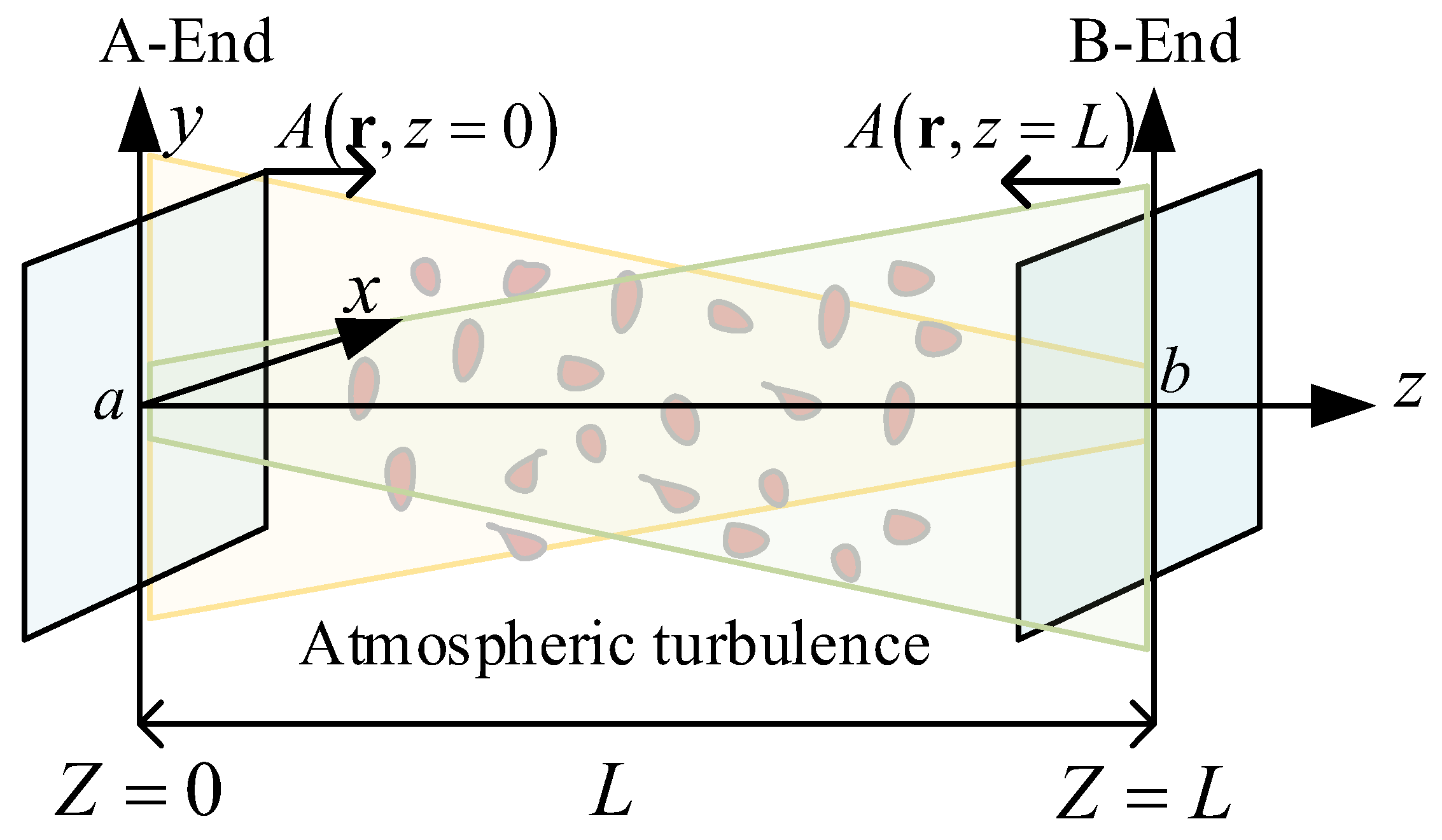

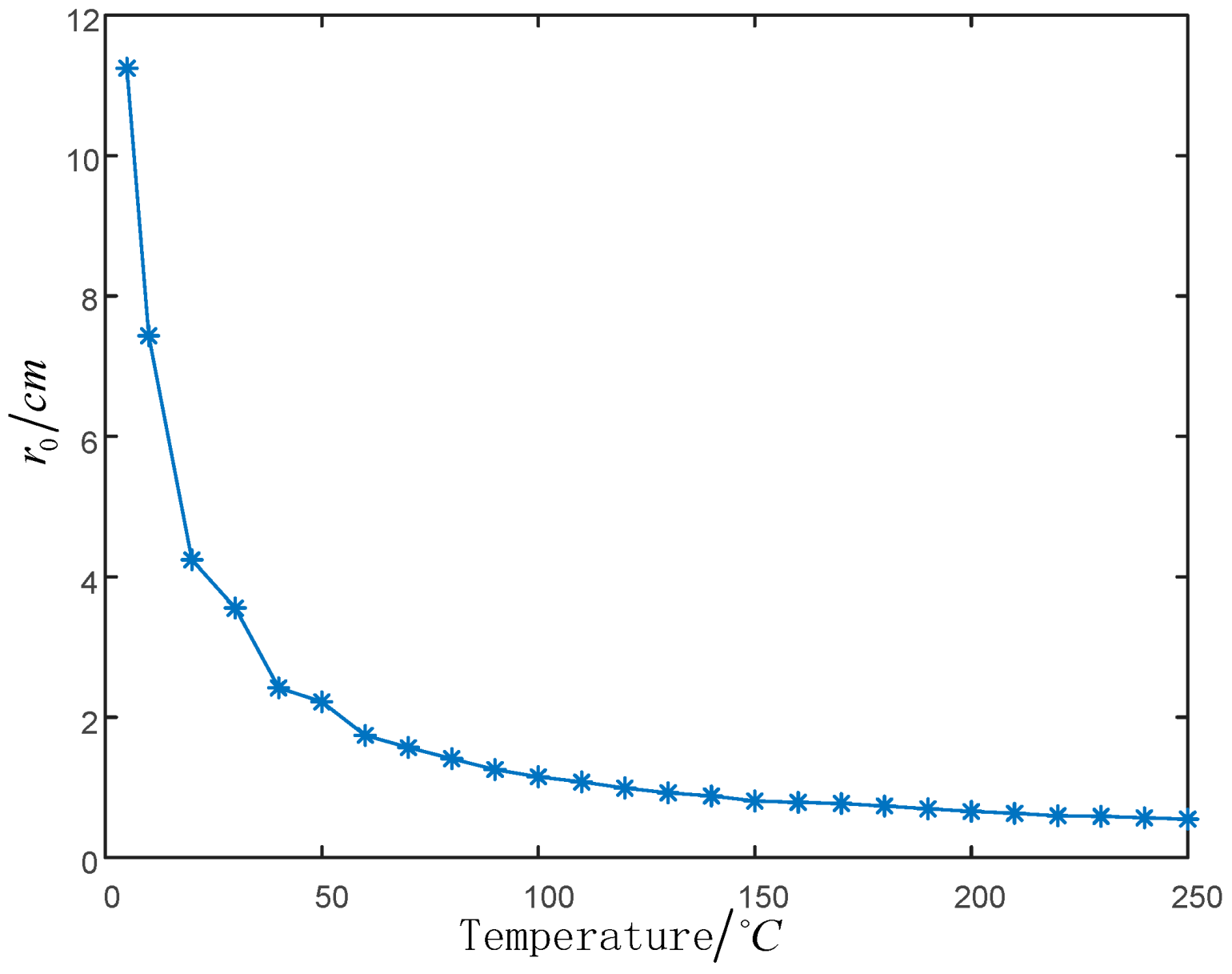
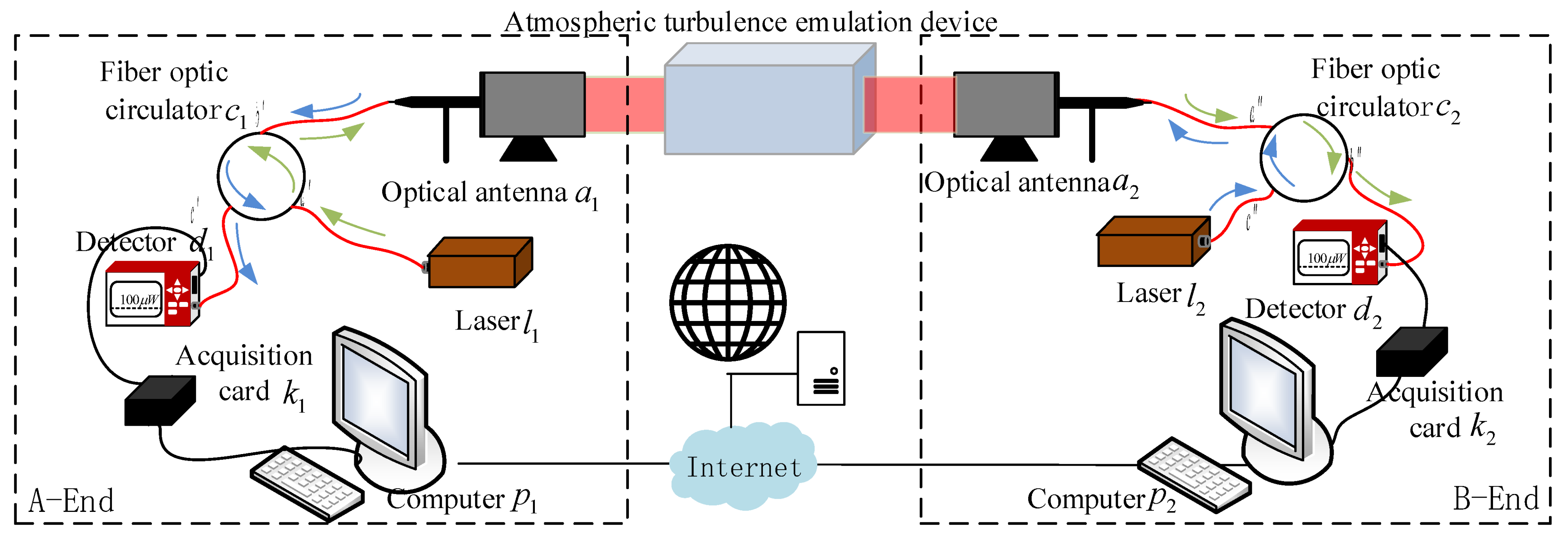
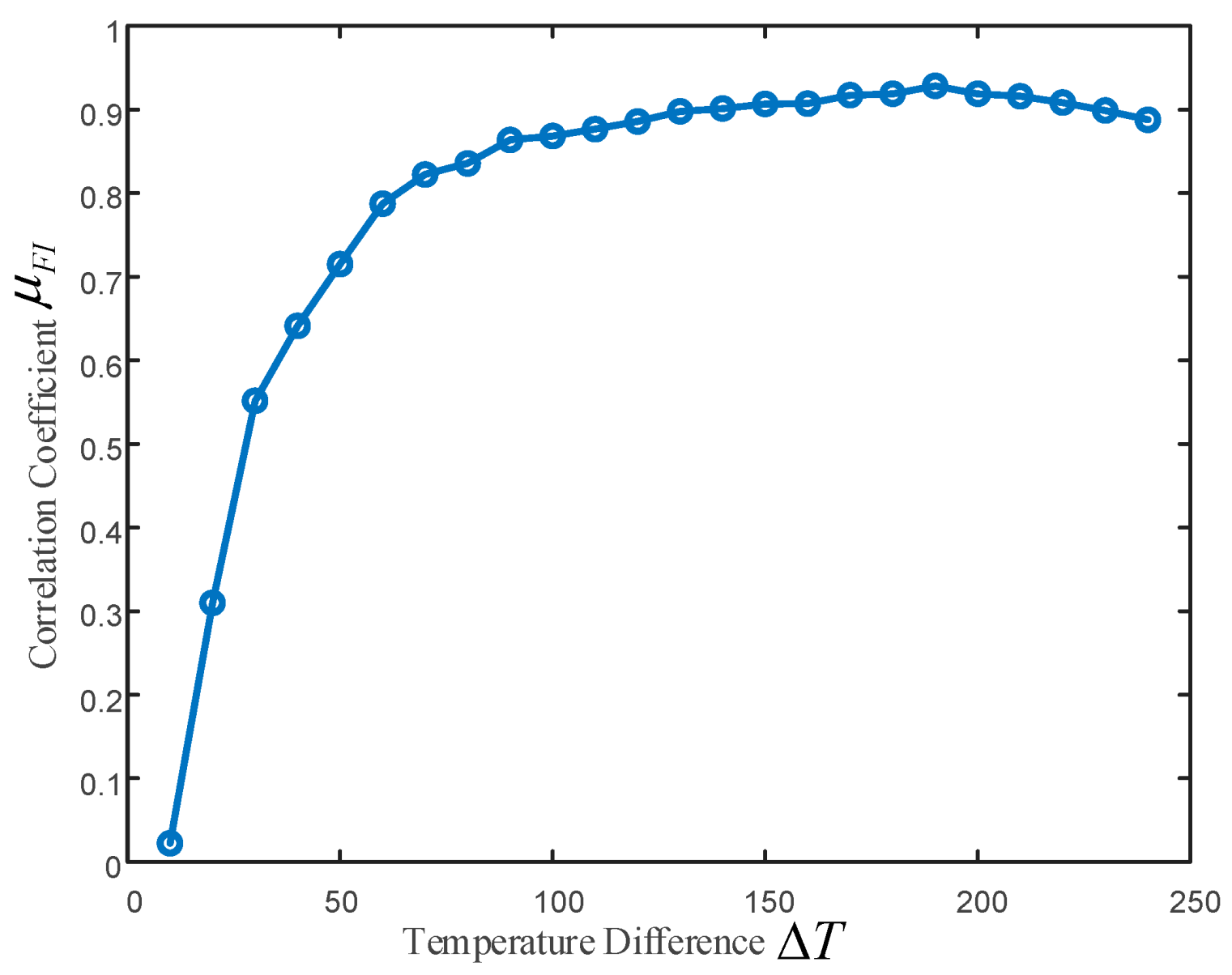

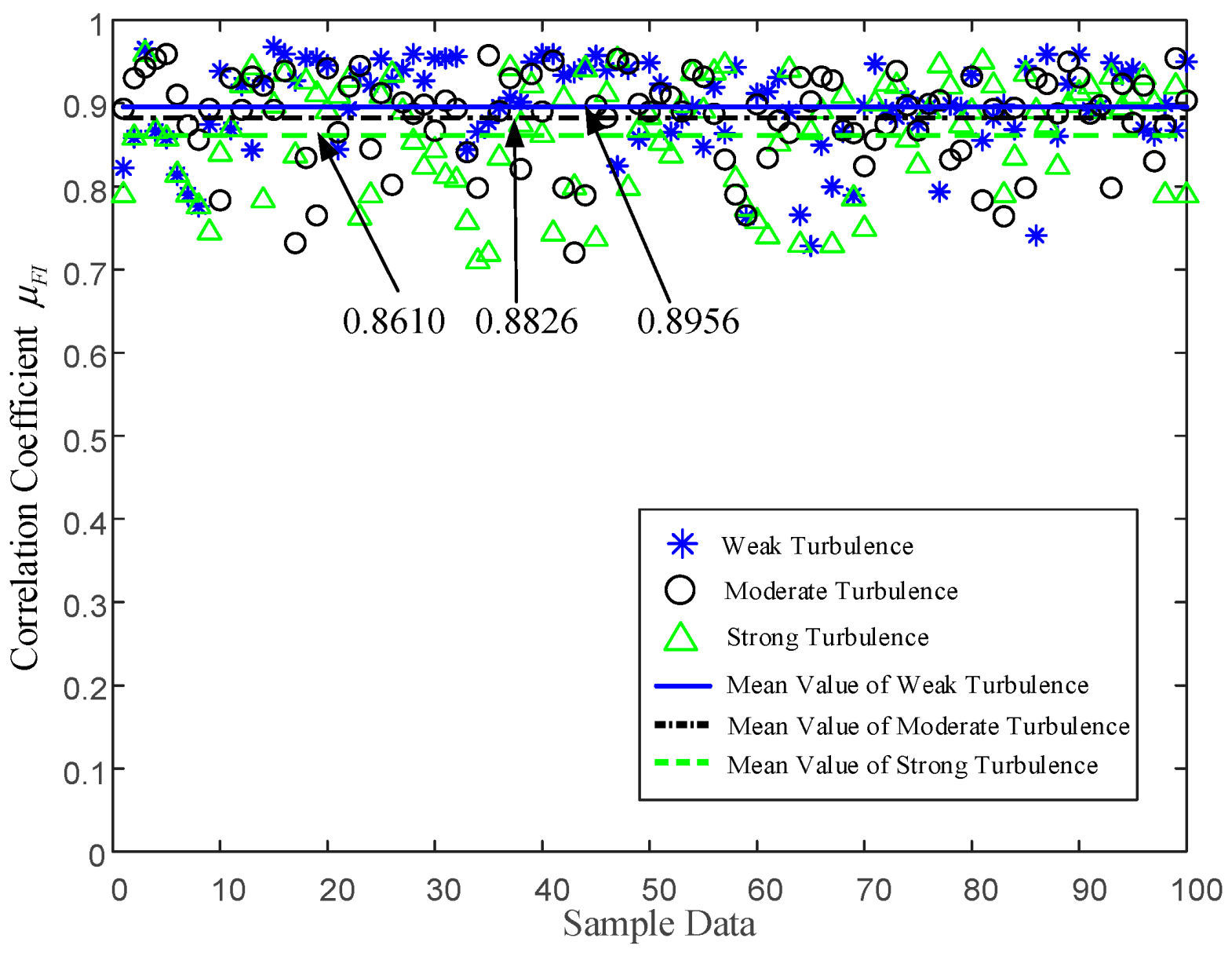
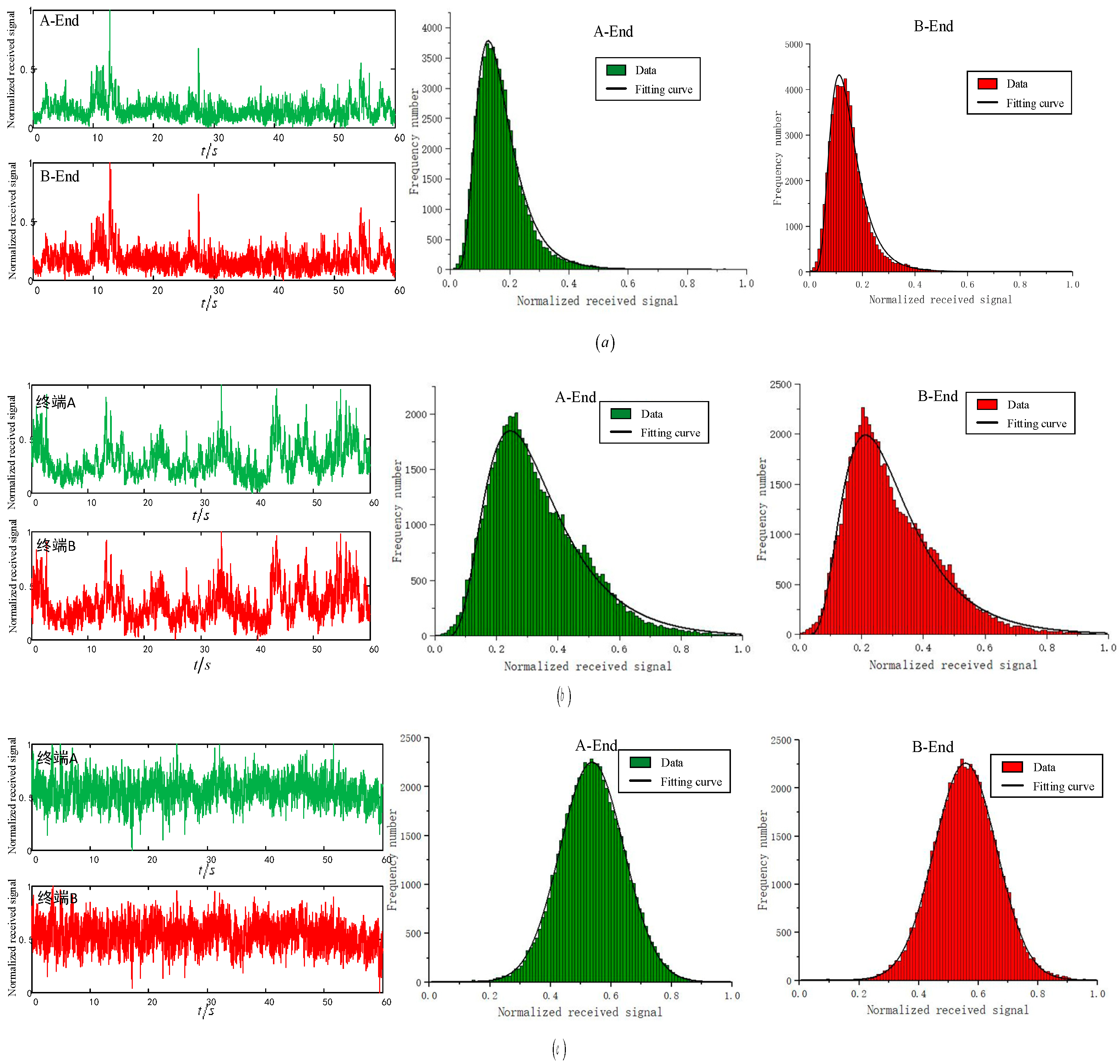
| Transmitter | |
| Aperture of optical antenna | the effective aperture: 80 mm |
| Laser | wavelength: 1550 nm output power: 0–20 mW |
| SMF circulator | isolation parameter: 40 dB |
| Atmospheric channel | |
| Coherence length | 1–40 cm |
| Intensity frequency range | 100 Hz |
| Characteristic velocity | >0.1 m/s |
| Turbulence intensity stability | 15% |
| Receiver | |
| Detector | wavelength range: 185 nm–25 um Power range: 100 pW–200 W |
Publisher’s Note: MDPI stays neutral with regard to jurisdictional claims in published maps and institutional affiliations. |
© 2021 by the authors. Licensee MDPI, Basel, Switzerland. This article is an open access article distributed under the terms and conditions of the Creative Commons Attribution (CC BY) license (https://creativecommons.org/licenses/by/4.0/).
Share and Cite
Liu, Y.; Liu, Z.; Chang, Y.; Liu, Y.; Jiang, H. Laboratory Measurements of the Influence of Turbulence Intensity on the Instantaneous-Fading Reciprocity of Bidirectional Atmospheric Laser Propagation Link. Appl. Sci. 2021, 11, 3499. https://doi.org/10.3390/app11083499
Liu Y, Liu Z, Chang Y, Liu Y, Jiang H. Laboratory Measurements of the Influence of Turbulence Intensity on the Instantaneous-Fading Reciprocity of Bidirectional Atmospheric Laser Propagation Link. Applied Sciences. 2021; 11(8):3499. https://doi.org/10.3390/app11083499
Chicago/Turabian StyleLiu, Yi, Zhi Liu, Yidi Chang, Yang Liu, and Huilin Jiang. 2021. "Laboratory Measurements of the Influence of Turbulence Intensity on the Instantaneous-Fading Reciprocity of Bidirectional Atmospheric Laser Propagation Link" Applied Sciences 11, no. 8: 3499. https://doi.org/10.3390/app11083499





